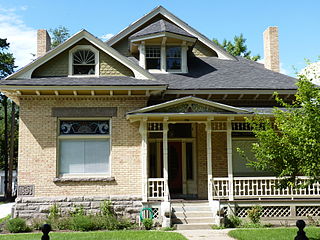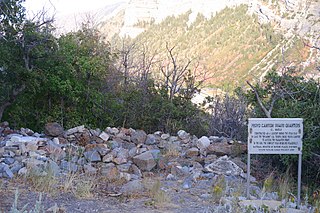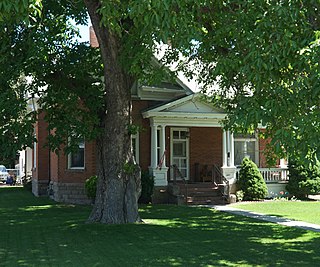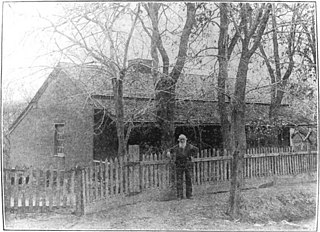
Lehi is a city in Utah County, Utah, United States. It is named after Lehi, a prophet in the Book of Mormon. The population was 75,907 at the 2020 census, up from 47,407 in 2010. The rapid growth in Lehi is due, in part, to the rapid development of the tech industry region known as Silicon Slopes. The center of population of Utah is located in Lehi.

Camp Floyd State Park Museum is a state park in the Cedar Valley in Fairfield, Utah, United States. The park is includes Camp Floyd, the Stagecoach Inn, and the Fairfield District School.

Temple Square is a 10-acre (4.0 ha) complex, owned by The Church of Jesus Christ of Latter-day Saints, in the center of Salt Lake City, Utah. The usage of the name has gradually changed to include several other church facilities that are immediately adjacent to Temple Square. Contained within Temple Square are the Salt Lake Temple, Salt Lake Tabernacle, Salt Lake Assembly Hall, the Seagull Monument, and two visitors' centers. The square was designated a National Historic Landmark District in 1964, recognizing the Mormon achievement in the settlement of Utah.

The Salt Lake City Council Hall is currently home to offices of the Utah Office of Tourism and the Utah Film Commission and is located on Capitol Hill in Salt Lake City, Utah. Built in 1864-66, the building is historically important as the Old Salt Lake City Hall or just Old City Hall from 1866 to 1894. It was designated a National Historic Landmark in 1975, as an emblem of the conflicts between the governments of the Utah Territory and the United States in the 19th century.

Camp Douglas was established in October 1862, during the American Civil War, as a small military garrison about three miles east of Salt Lake City, Utah, to protect the overland mail route and telegraph lines along the Central Overland Route. In 1878, the post was renamed Fort Douglas. It was officially closed in 1991 pursuant to BRAC action and most of the buildings were turned over to the University of Utah. A small section of the original fort is still used by the U.S. Army Reserve and includes the Fort Douglas Military Museum. The fort was designated a National Historic Landmark in 1975, for its role in the Civil War and in furthering the settlement of Utah.

Emigration Canyon is a metro township and canyon in Salt Lake County, Utah, United States, located east of Salt Lake City in the Wasatch Range. Beginning at the southern end of the University of Utah, the canyon itself heads east and northeast between Salt Lake City and Morgan County. The boundaries of the metro township do not extend to the county line, nor do they encompass all of Emigration Canyon, as parts of it are within Salt Lake City. As of the 2010 census, the population was 1,568.

The Brigham Young Complex is a collection of buildings historically associated with religious leader Brigham Young on East South Temple in the center of Salt Lake City, Utah.

The Henry J. Wheeler Farm is a farmstead in Murray, Utah, United States, that is one of the few remaining late 19th century farmsteads in the Salt Lake Valley that has not been lost to expanding housing developments of metropolitan Salt Lake City. It has been listed on the National Register of Historic Places since 1976.

The Harvey H. Cluff house is a house in central Provo, Utah, United States, built in 1877 that is on the National Register of Historic Places. It was originally owned by Harvey H. Cluff.
Richard Karl August Kletting was an influential architect in Utah. He designed many well-known buildings, including the Utah State Capitol, the Enos Wall Mansion, the original Salt Palace, and the original Saltair Resort Pavilion. His design for the Utah State Capitol was chosen over 40 competing designs. A number of his buildings survive and are listed on the U.S. National Register of Historic Places including many in University of Utah Circle and in the Salt Lake City Warehouse District.

The Charles E. Loose House is a historic house located in Provo, Utah, United States. The house was individually nominated for listing on the National Register of Historic Places in 1982 but was not listed due to owner objection. It later was included as a contributing property in the Provo East Central Historic District.

The Samuel H. Allen Home is a historic house located at 135 E. 200 North in Provo, Utah. It is listed on the National Register of Historic Places.

The John R. Twelves House is a historic house located in Provo, Utah, United States. It is listed on the National Register of Historic Places.

The Provo Canyon Guard Quarters is a historic building located in Provo, Utah. It is listed on the National Register of Historic Places.

The Provo Downtown Historic District is a 25-acre (10 ha) historic area located in Provo, Utah, United States. It is listed on the National Register of Historic Places.
Walter Ellsworth Ware was an American architect who established a firm in 1891 in Salt Lake City, Utah and practiced until 1949, over a period of almost 60 years. He designed numerous buildings of diverse styles and functions that remain standing, many of which are listed on the U.S. National Register of Historic Places.

The Thomas and Mary Webb House, is a historic residence in Lehi, Utah, United States, that is listed on the National Register of Historic Places (NRHP).
40.7244°N 111.8146°W The First Congregational Church of Salt Lake City, Utah is a Congregational church affiliated with the National Association of Congregational Christian Churches. Established in 1865, it was the first church not a part of The Church of Jesus Christ of Latter-day Saints in Utah. The congregation started Utah's first free public schools.
A pair-house is a three-room house found in the US built in the 19th century by Scandinavian immigrants as an adaptation of common houses from their homeland. Commonly found in the US state of Utah, pair-houses are historically significant as being representative of ethnic diversity in an area and time that favored uniformity among followers of The Church of Jesus Christ of Latter-day Saints. A number of pair-houses are listed on the National Register of Historic Places.

The John Steele House is the historic home of a prominent early resident of Toquerville, Utah. One of the Mormon pioneers, John Steele built the house in 1862 and lived there until his death in 1903, working as an herbal physician and serving in a number of town and county offices. Its floor plan is a rare double-parlor style.


















